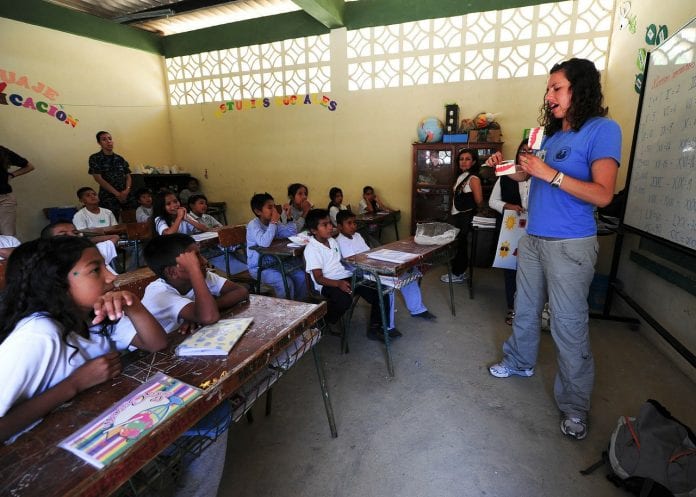The National Institute of Mental Health places the number of children with ADHD at between 3% and 5% of the population. That would mean, in every classroom of 25 to 30 children, at least one child will have ADHD. Teachers, therefore, are on the front line in working with and helping children with ADHD.
During the school day children are expected to sit still, stay in their seats, focus on their lessons and remember what they have been taught and what they are to do next. These are the same areas in which children with ADHD have the most difficult time. Many children with ADHD are intelligent and creative. They do not have a problem understanding the concepts being taught, but may not be able to complete their work because of the difficulty they have staying on task. Children with ADHD are also often emotionally immature and have low self-esteem.
Teachers, especially those with large classrooms are often pressed for time. They do not have the ability to individually help each child but must instead teach the group. With both limited time and resources, teachers can be at a loss as to what they can do to help the child with ADHD in their classroom.
There are a number of ways in which teachers can provide extra assistance or help foster success in children with ADHD and minimize the distractions each day:
Seat the child where distractions are minimized.
This might mean having the child sit directly in front of the teacher or in the front row. This might mean placing the child in a seat close to students that easily focus and concentrate, minimizing the amount of time a child fools around with neighbours. Sitting a child with ADHD by the doors or windows is probably not a good idea as the activity outside can cause constant distractions. When creating a seating plan or rearranging seating, do not call attention to the child’s special needs. Simply place the child in the place you feel would be best.
Use a signal to help the child stay on task.
Create a special signal between you and the child. This could be tapping your pencil on your desk, walking around the classroom, or tapping on their desk. This will be a sign for the child to get back on task. Your student may also want to create a signal for you that they do not understand and may be embarrassed to ask a question out loud. Provide them with a signal that will allow them to let you know they do not understand. As a teacher, you can offer assistance in the way of teaching the concept or idea to the entire class rather than singling out one student.
Find ways to praise the child.
Accept effort as an accomplishment and take the time to praise the student on the effort they make or if they complete a task. Just a small word as they are leaving your classroom can mean a great deal to a student that feels they do not live up to adult’s expectations.
Centre constructive criticism between compliments.
If you do find the need to let the student know about something they have done incorrectly, find something they have done well and let them know about that first. Then offer your constructive criticism. Finally, let the student know that you appreciate their effort. This will allow the student to feel good about themselves and they will be more open to listening to your remarks and trying to live up to them.
Find opportunities to allow hyperactive children to use their energy.
If you have notes to send to the office, let them take them. If you have papers to hand out to your class, let them hand them out. If you have classroom chores, such as cleaning the board or straightening up supplies, let them help. By providing opportunities to move around, you will be helping them stay still during periods when sitting in their seat is a necessity. Do not take away recess or lunch periods to finish work or complete tests. Children with hyperactivity need these breaks to use up excess energy.
Have a child look directly at your eyes when speaking to them.
Children with ADHD will pay attention more when they are looking directly at you. In addition, you will be able to see the moment attention begins to wander and will be able to bring their attention back to you before continuing.
When giving directions, keep them short and simple.
If longer or more complicated directions are required, provide a written sheet or write directions on the board. For example, if you want your students to read a chapter in the book, answer questions on a worksheet and then gather items to go home, write them on the board so the students are not wondering what to do next once they have completed a task.
Create a system to make it easy for parents and students to get homework assignments.
Create a website you can update with homework assignments, test schedules and information about upcoming projects. Have a homework helpline where students and parents can call to find out the day’s homework assignments. Create an email mailing list and send an email each day or each week with assignments, test and project information.
Find a student that can work as a “homework buddy.”
One of the major difficulties for students with ADHD is remembering not only what is for homework but remembering what items to bring home each day. Have the “homework buddy” work with the student with ADHD each day when packing up to go home. Have them help the student be sure to bring home all books and papers needed to complete their homework.
Reduce homework assignments.
Many students with ADHD will take hours to complete their homework each night causing frustration for the parents, family members and the student. Reduce homework assignments for the student with ADHD by having them complete the odd or even problems or provide enough homework to make sure they have learned and comprehended the work but are not overwhelmed with homework.
As teachers work with the above ideas, I am sure they will begin to find even more ways to reach out to the students with ADHD. Helping them find success in your classroom is rewarding for both the teacher and the student.
Root Element offers Essential Oil blends to assist in relieving ADHD symptoms and enhances focus and concentration. Available in Roller Bottles and Diffuser Bottles ideal for Classrooms. For more information, please visit our website
www.rootelement.co.za















